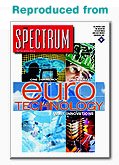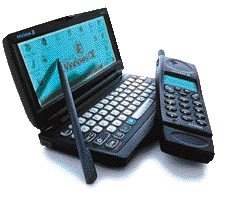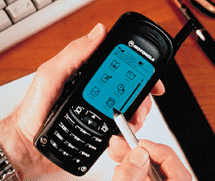![]()
| UMTS | |
|
Whitepaper
 Building on
the success of its home-grown cellular system, Europe is planning a
next-generation wireless system to handle data as well as voice and - it
is hoped - lay the foundation for universal roaming.
Building on
the success of its home-grown cellular system, Europe is planning a
next-generation wireless system to handle data as well as voice and - it
is hoped - lay the foundation for universal roaming.
CONTENTS
- Introduction
- Cellular evolution
- UMTS connections
- Service concept
- Network architectures
- Making the transition
- Smart phones
- In the years ahead
- About the author
INTRODUCTION
In the past decade, mobile telephony has grown faster than anybody predicted. Inexpensive phones with built-in facilities and applications and lower per-call rates have made mobile services an essential part of life for many users. Business and commerce rely heavily upon mobile services, and many job entrants, students, and young people use cellular phones as their primary telephone.
The Global System for Mobile Communications (GSM), the cellular system used throughout Europe, has grown very rapidly since being introduced in 1992 and is now by far the world's most successful wireless standard. It has more than 100 million subscribers in 120 countries, and it attracts more than five million new users every month. There are nearly 300 GSM system operators worldwide, and last year almost 60 percent of all digital cell phones produced were GSM.
A new mobile system for worldwide use is now being developed to enhance and supersede current systems. Often referred to as the Third Generation Mobile System target [see table], it will be an enhanced digital system and will provide universal personal communications to anyone, regardless of their whereabouts. It will allow for wireless Internet access, videoconferencing, and other wide-bandwidth applications.
In Europe, the system being developed in the framework of the European Telecommunications Standards Institute (ETSI) is called UMTS (Universal Mobile Telecommunication System). ETSI is based in Sophia Antipolis, France. In parallel, the International Telecommunication Union, based in Geneva, is formulating IMT (International Mobile Telecommunications) 2000, which is to be a family of systems that will let users roam worldwide with the same handset, and which will include UMTS as a subset.
Although UMTS will be a major step forward for both customers and technology, there is little time to develop and implement commercial standards. Japan plans to launch its UMTS network in the year 2000, and the United Kingdom wants its UMTS radio interface working alongside and enhancing GSM networks by the year 2002. By 2005, the UK expects its first fully working UMTS network to operate compatibly with its legacy systems. The rest of Europe should be using UMTS shortly afterwards.
Meanwhile, IMT 2000 will ensure that third-generation systems are globally compatible and provide uniform communications. The idea is to achieve this by encouraging all interested parties to work toward convergence of technologies that otherwise might compete against each other. Currently, however, that dream is somewhat clouded by a dispute between leading European manufacturers and Qualcomm Inc., San Diego, over the terms on which its intellectual property will be used in UMTS/IMT and the very character of the third-generation standards [see "Europe battles U.S. company over CDMA standard"].
CELLULAR EVOLUTION
Bell Laboratories invented the cellular concept, and the first commercial analog systems introduced in the early 1980s were designed purely for voice communications. The advanced mobile phone system (AMPS), the first (pre-operational) system, was introduced to Chicago in 1979. The North European countries devised the Nordic Mobile Telephone (NMT) system for Scandinavian coverage in 1981. It started in Sweden and quickly expanded to Norway, Denmark, and Finland. The UK introduced its first cellular system in 1985 using an analog standard called TACS (total access communications system), based on the AMPS system.
Thus, users were largely confined to the systems their phones were designed for, roaming between systems was virtually impossible, and there was no agreed-upon path for getting the various first-generation systems onto a common platform.
GSM grew out of the first-generation cellular system's limitations and the desire of European countries to develop a common cellular telephony standard. In June 1982, the first meeting for the second-generation system was held in Vienna and a new standardization body called Groupe Spéciale Mobile (GSM) was born. The first meeting was held in Stockholm in December 1982, with 31 people from 11 countries attending. Its goals were to help develop high-volume, mass-market products that would reduce the cost of cellular services, make roaming between countries easy, and introduce integrated services such as data, fax, and short messages, in addition to encrypted digital speech and advanced fraud protection.
GSM is not just a radio interface but a specification for a complete network, which was to be launched in various stages, with phase 1 covering basic service and phase 2, enhanced services. The term GSM was retained as the commercial trademark for the 900-MHz system.
Although there is no tight, unambiguous definition for the third-generation mobile system, the goal of system operators, manufacturers, and governments is to provide high functionality with seamless global roaming. Third-generation systems should support high-speed data and multimedia applications of up to 144 kb/s while moving any distance, and up to 2 Mb/s wireless access in a local area. The third-generation mobile system is designed to give users consistent voice, data, graphical, multimedia, and video-based information service, regardless of their location on the network (cordless, cellular, satellite, fixed/wireline, and so on).
Note that UMTS will support data-rates of much more than 2 Mb/s in wireline service. Whereas the previous mobile systems were separate from wireline telephony systems, Europe wants UMTS to integrate wireline and mobile systems.
In a nutshell, UMTS can be split into two main areas of standards-setting: core network and wireless access. To date, most of the work has concentrated on the wireless part; UMTS will be introduced in Europe by the year 2002 in the form of the UMTS air interface.
UMTS CONNECTIONS
The new wireless wideband systems will offer both real time (for example, for speech) and non-real-time modes (say, for e-mail) using common transport mechanisms. The future transport mechanism will provide an efficient transport mechanism for message, file, and stream-type data defined as:
- Message packet data: time-delay tolerant, but requiring a low bit-error rate (BER). This is generally a fixed-length single packet, for handshake-type operations, and for signaling packets and mobile features like SMS (short message service).
- File packet data: for multiple packets, also time-delay tolerant but requiring the data to arrive perfectly intact (whereas with speech, for example, some bits can be lost). The content varies in length and could include downloading Internet pages, transferring files, e-mail, and so on.
- Stream connection-oriented data: separable into two subgroups. "Speech" and "video phone" applications are stream-delay intolerant but more flexible in their BER demands. Video broadcasts have some stream-delay tolerance, such as where the terminal may store the data, but small time delays are acceptable.
Each type of application requires different characteristics of its communications link. UMTS will provide the appropriate access mechanisms for each application, obtain maximum network efficiency, and save customers money.
Higher bandwidths, asymmetrical connections, and dynamic bandwidth allocation will offer better system flexibility for both network operators and customers. The network operator will make more efficient use of network resources like the radio spectrum. Customers may save money by being able to pay per data packet. Current services generally force them to pay for a set bandwidth that is wasteful because data is usually "bursty" and the connection is rarely used to its maximum.
Employing the Internet as an example, the user sets up a data connection to a service provider (normally a two-way symmetrical link equating to a two-way 9.6-kb/s link in GSM). When a page is initially accessed, the user requires a large data dump. The application is time tolerant, and packets of data arrive at different times. The traffic is mainly one way (downloaded).
Once the information is received, the customer normally reads the page and keeps the communications link alive. UMTS will maintain a virtual link, by means of a signaling (as opposed to the data) channel, so that once the data has been downloaded, the customer pays nothing more until the next information request. In addition, UMTS will potentially offer an asymmetrical two-way link allowing large data-dumps to the customer while retaining only a small link in the opposite direction. During the time the user is reading the downloaded page, network resources can be reallocated to other users.
SERVICE CONCEPT
The third-generation mobile system is customer focused: its aim is to provide seamless services regardless of terminal type, network, or access method. As part of the service ethos, the virtual home environment (VHE) is another new customer option. VHE will let customers retain and personalize their services anywhere--and use them at any time in both wireless and wired environments. Third-generation systems also will allow users to determine the quality of the voice or video call, and pay accordingly.
Users will have specific services--voicemail, fax, and perhaps some video services--which they will resort to regularly. They may also set up an easy way to access the services, possibly using a Web browser and short codes to telephone friends. If the customer roams to a different country and hence to a different network operator, UMTS will ensure that the specific services are not only available, but that his or her preferences are retained. The preferences may include how goods purchased over the Internet are paid for and how services react when the bandwidth is decreased. With videoconferencing, a customer may opt to retain high-quality speech and to lose the video when the bandwidth or link quality declines.
Employing the same mobile videoconferencing example, a user may set up a videoconference with a colleague while in the office. The office will provide high-bandwidth access (possibly a private cable with much more than 2 Mb/s or a wireless picocell with up to 2 Mb/s). The network/application will choose a video-coding standard (in software) that provides both high-quality pictures and high-quality sound.
During the conversation, the user may travel out of town and continue the video call. Once the office is left behind, the high-bandwidth access will be lost and the available data-rate will drop back to an umbrella cell. But as the user travels, the communications link may hand over to an overlay cell with a lower data-rate. Since the video-coding algorithm used is optimized to work over high bandwidth, it will not be able to deliver the same high-quality video originally negotiated.
One way to overcome the drop in bandwidth could be to change the video coder/decoder (codec) to operate on a lower bandwidth by changing the compression ratio. Since the codec is in software, changing it is a simple case of redirecting the video stream to the appropriate codec program, in the terminal, to adjust the picture quality to suit the available bandwidth. The user terminal would, of course, have to support the video standard and run the video decoder software. While the picture quality would change, the user would retain the service. In this case, the user may have to choose between lower-quality pictures or high-quality voice.
Traditionally, the equipment's capabilities and a communications network's signaling protocols determine the communication links, capabilities, and applications such as voice quality. The concept of dynamically allocated data rates and changing coding standards is new and requires more work before it can be used commercially. While the idea has been proved in the laboratory, it is still five years away from commercial production.
NETWORK ARCHITECTURES
The UMTS system offers a layered approach to coverage. In small, localized areas (picocells) like offices or homes or filling stations, for example, the available radio access bandwidth is relatively high, up to 2 Mb/s. The picocell will be covered by a larger microcell, which offers a lower bandwidth of 384 kb/s and may cover a few square kilometers.
The picocell and microcell will be covered by a larger macrocell offering even lower bandwidth services (144 kb/s) over a large area such as a city. A global system of satellites will cover remote areas. While much attention is being given to cellular operators, UMTS also applies to wireline operators. The latter will offer the same capabilities and provide higher bandwidths, including broadband services.
Thus, substantial progress has been made in defining wireless standards for third-generation systems. But there is a lot of debate about how UMTS will be implemented in network architecture since the core specifications have not yet been defined. The future network must support different access mediums--from wireless local loop to cellular to corporate wireless local-area network (LAN). This means adapting data transfer rates from 9.6 kb/s (the current GSM data rate) to 5 Gb/s for full broadband data.
Since cellular network operators have a considerable investment in GSM, it is unlikely they will dump old technologies and invest in new ones in a single step. (A wireline operator does not have this problem and may want a full UMTS network from day one.) UMTS must also be compatible with legacy systems. Generally, the older the legacy system, the fewer new services that can be supported.
GSM operators are still introducing new features based on a new intelligent network (IN) platform, allowing customers to use operator-specific services regardless of the network operator's location. This means that special services (such as short code dial to get the weather) can be accessed in any country. Currently short code dials such as "901" in the UK to get voicemail do not work in other countries.
MAKING THE TRANSITION
UMTS will be phased in just as GSM was, and GSM's ongoing evolution will ease the transition to UMTS. New network architecture will be introduced within a year to expand GSM services. These services, called GPRS (general packet radio system), provide packet data or connectionless services that add functionality and flexibility to existing GSM services.
While current data services offer 9.6 kb/s, packet services will offer higher transfer rates. The mechanism used provides a standard packet rate of between 9 kb/s and 20 kb/s. The variance exists because the system adapts to different radio environments. When radio signals are good, less error protection is needed, so the network can drop the number of error protection bits in each packet. When the radio environment is harsher, more error protection is required, so fewer bits are available to the user. The network will determine which scheme is used, although the user can request a specific data throughput. Packet services also enable data packets to be concatenated, offering higher transfer rates.
In addition to network changes, the GSM radio interface is being modified to offer new coding schemes that increase the standard GSM data rate of 9.6 kb/s up to 69.2 kb/s on a single time slot. Called EDGE (enhanced data rates for GSM evolution), this development is now being discussed in the GSM standards forum, and would involve using different radio-coding schemes so that more bits may be transmitted within the same bandwidth.
Both GPRS and EDGE introduce variable data rates and asymmetrical services by combining technologies and different coding schemes to uplink and downlink traffic. These new architectures and services will help soften the edges between current GSM systems and UMTS.
The radio interface of UMTS is called Utran (UMTS terrestrial radio access network) and is now being specified by the European standards bodies. Utran defines the radio interface and type of radio transmission system and protocols that will be used for UMTS.
Like GSM, the Utran system will consist of a number of hierarchical layers. The higher-layer macrocell will use W-CDMA's frequency-division duplex. The user will be given a special CDMA code and total use of the frequency spectrum allocated. The macro layer will provide the basic data rates of up to 144 kb/s. The lower layers will provide the higher data rates of 384 kb/s and 2 Mb/s by means of frequency-division duplex but with more codes. It may also be possible to use a time-division duplex approach for the higher data-rates. This is achieved by dividing the frequency allocation into time slots for the lower layers.
The combination of different access methods is intended to provide both flexibility and network efficiency. The UMTS terminal will adopt the access method that best suits its environment; this will give optimum performance. Current plans are for the Utran (UMTS phase 1) to be GSM phase 2-plus. The situation is complicated, however, by Qualcomm's desire for the Europeans to use their specific implementation of CDMA.
SMART PHONES
While mobile phone usage has been growing at a fast pace globally, mobile data usage in the public arena is low. Several reasons account for this sluggish acceptance:
- Low data-rate: GSM offers only a 9.6-kb/s transfer rate.
- Complexity: users not only need a personal computer, a cell phone, and potentially a data card, but also the ability to configure, run, and ensure that the other end of the system is also set up properly.
- Expense: in many countries, cellular service is still costly.
- Unfriendly data support: people complain that they need a science degree to configure and run the services.
It is interesting to compare current mobile data usage with forecasts suggesting a massive swing toward mobile data. This will not happen immediately. Many factors will combine to encourage this trend. While the higher data- rates offered by advanced GSM and the UMTS network should increase usage, other areas such as terminal evolution and dual-mode handsets will push the process along.
A dual-mode handset looks like a cell phone but has more than one technology inside. It may combine GSM at different frequencies--900 MHz in the UK, 1900 MHz in the United States--so customers can use their phone on both continents. Dual-mode handsets now offer GSM/DECT (for digital enhanced cordless telecommunications) and GSM900/GSM1800 (1800 MHz offers higher capacity and has been reserved for GSM in Europe; it is also referred to as DCS1800, or the digital cellular system).
GSM/satellite will soon appear with systems being put into earth orbit by Iridium, Globalstar, and ICO. These devices will soften the edges between technologies and networks, support global roaming, and make digital voice and data communications available everywhere.
With improvements in electronic integration, credit card-sized cell phones that can slot into a standard PC are appearing. It takes little imagination to foresee multimode handsets incorporating the many radio access methods used across the globe and so providing true worldwide coverage. The concept of the world phone is dawning [figure 1]. GSM 900, DCS 1800, and the United States' PCS 1900 (personal communications system) rely on the same basic GSM architecture; the main difference is the frequency used. Some satellite systems such as Iridium will interconnect seamlessly with terrestrial wireless networks.

Figure 1 - Ericsson's M 16, used in conjunction with one of the company's mobile phones, permits the user to send and receive e-mail, faxes, and short messages, browse the Internet, and work anywhere with Windows CE 2.0 applications.
Smart phones are also emerging. They add PC/organizer functionality to a cell phone/wireless terminal, beyond what has already been seen. Initial products combining organizers and cell phones such as the Nokia 9000 are being upgraded to products like the Alcatel OneTouch COM smart phone with touchscreen technology to provide user-friendly interfaces. These terminals have a touchscreen on the front of the phone that changes the display from cell phone to organizer at the touch of a "virtual button." Users can send and receive e-mail and the device can be used either longitudinally or laterally [figure 2].

Figure 2 - Motorola's Smartphone series, besides providing the ability to handle electronic mail and faxes and access the Internet, allows for connectivity to personal computers or databases.
Smart card technology is also being introduced into second-generation systems like GSM. Currently, the smart card technology incorporated in GSM makes use of a removable card located inside the telephone called the SIM (subscriber identity module). The SIM talks to the network and grants the user network-access rights. It can be used as an extra storage facility for a contact directory. The capability of the SIM will expand so programs can be downloaded by the air interface.
Beyond the five-year horizon, other developments such as the softphone are expected. A softphone is a handset that operates on different technologies and uses the most appropriate frequency for its location. The idea is for the phone to configure itself for any access network, such as GSM 1900 or GSM 900, and for any voice system, such as GSM or satellite, by downloading the appropriate technologies as software. This means the terminal would configure itself to operate with local network technology, no matter where the user is.
IN THE YEARS AHEAD
UMTS will promote integrated and seamless services and offer universal communications regardless of the terminal, network, or location. Network operators will combine wired and wireless networks, not to mention public and private/corporate networks. The concept of the virtual home environment combined with enhanced terminals with sophisticated user interfaces and services will smooth the customer's transition. The technological building blocks are coming together rapidly, and this capability, combined with ever-heightened customer expectations, will help drive the UMTS goal of allowing users to communicate on any terminal, through any network, anywhere on the planet.
ABOUT THE AUTHOR
William Johnston is a senior mobile R&D engineer at British Telecommunications Laboratories, Martlesham Heath, Ipswich. He works in the mobile data and multimedia area and is part of a team developing future generation systems.

© British Telecommunications plc, 1999
